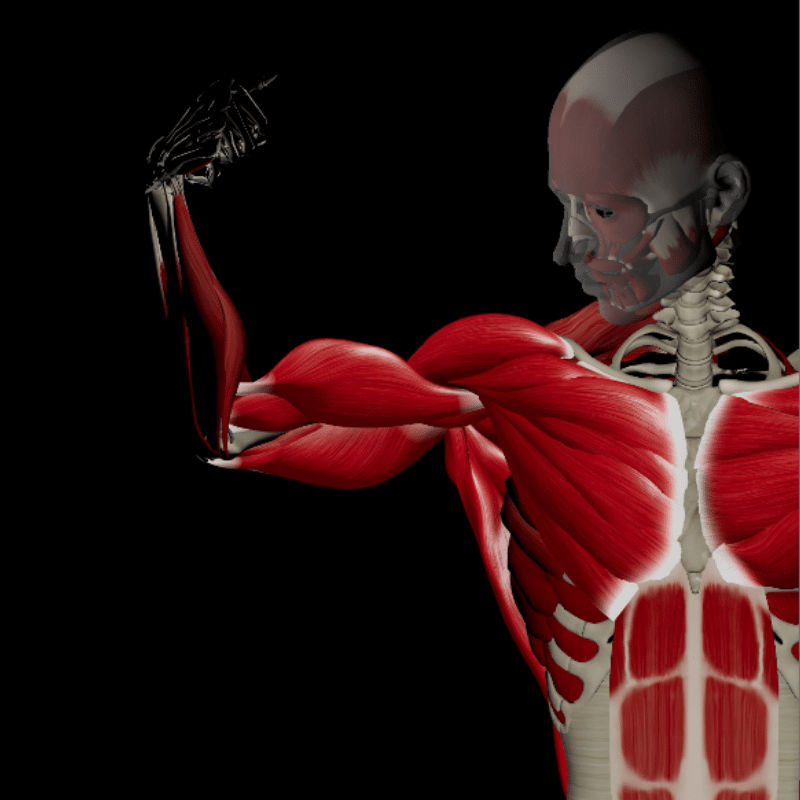Imagine a simple yet powerful way to enhance your health, longevity, and quality of life—it comes down to building and maintaining lean muscle mass.
While many people focus on losing excess fat for better health, they often overlook the equally critical need for maintaining sufficient muscle mass.
Lean muscle mass is not just about aesthetics; it is crucial to our overall health and longevity.
Did you know that lean muscle mass can save your life? Beyond making you stronger and preserving your function as you age, muscle mass plays a vital role in overall survival.
In this Muscle and Motion article, we will explore how maintaining and building lean muscle mass can positively impact your life and potentially save it.
We will explore the many vital functions of muscle mass beyond strength and aesthetics and understand why it should be a key focus in our health and fitness goals.
What is lean muscle mass?
Lean muscle mass is the amount of muscle in your body. Two people might look similar on the outside or weigh the same, but if you measure their muscle mass, one might have significantly more muscle, while the other might have less muscle under the skin.

Can muscle mass save your life?
Reduce the risk of mortality
Studies show that higher muscle mass is linked to lower all-cause mortality rates. For example, Abramowitz et al. (2018) demonstrated that individuals with greater muscle mass have a significantly reduced risk of death.[1] Similarly, a 2012 study by Rantanen et al. found that midlife muscle strength is associated with longevity up to age 100, highlighting the long-term benefits of maintaining muscle strength.[2] A higher muscle mass is likely associated with significantly lower total mortality. Specifically, those in the highest quartile of muscle mass index had a 19-20% lower mortality risk than those in the lowest quartile.[3]
Improved glucose metabolism and insulin sensitivity
Skeletal muscle, which consists of about 600 muscles and is the largest organ by mass in the human body, plays a vital role in managing blood sugar levels and enhancing insulin sensitivity. After eating, these muscles help clear about 80% of the sugar from the bloodstream, which is crucial for maintaining healthy blood sugar levels.
For example, in type 2 diabetes, muscle cells often become resistant to insulin, making it difficult for glucose to enter the cells. This leads to high blood sugar levels and places extra strain on the pancreas, potentially worsening the condition over time.[4]
Regular exercise increases muscle mass, which releases special proteins called myokines. Myokines regulate various processes, including muscle growth, energy use, and inflammation. They help improve the body’s ability to manage sugar and fat levels by enhancing insulin sensitivity. This improved insulin sensitivity allows glucose to enter muscle cells more efficiently, reducing blood sugar levels and easing the burden on the pancreas.[4]
Increased basal metabolic rate
Basal metabolic rate (BMR) is the number of calories your body needs to perform essential life-sustaining functions, such as breathing, blood circulation, and cellular processes. Your BMR is primarily influenced by your lean body mass, especially muscle mass because muscle tissue requires more energy to maintain than fat tissue. Having more lean muscle mass boosts your BMR, enabling you to burn more calories even at rest. This increased calorie burn can aid in weight loss and help prevent obesity, making it easier to maintain a healthy body weight. Regular strength training and resistance exercises are effective strategies to build and sustain muscle mass, thereby enhancing your metabolic rate and supporting long-term health and vitality.
Improve prognostic in cancer patients
Skeletal muscle mass is a critical prognostic factor for cancer patients, activity levels, and treatment-related toxicities. In a recent study, sarcopenia, measured by the skeletal muscle mass index, was linked to increased all-cause and cancer-related mortality among cancer survivors. Higher skeletal muscle mass decreases mortality risk for many types of cancers (prostate, colorectal, breast).[5]
Enhanced physical function and reduced injury risk
Strong muscles support better mobility and stability, reducing the risk of falls and injuries, especially as you age. This is particularly important for maintaining independence and quality of life in older adults. Muscle mass is a reservoir important for recovery from severe illness, injury, or surgery. Individuals with greater muscle mass recover more quickly and effectively from such conditions. This enhanced recovery capability can significantly improve outcomes and reduce the duration of hospital stays, thus positively impacting overall survival.
Protection against sarcopenia
Sarcopenia, characterized by age-related loss of muscle mass and function, significantly impacts mortality rates. Research indicates that sarcopenia is associated with a 100% increase in the risk of mortality among older adults. The prevalence of sarcopenia ranges from 9.9% to 40.4% in community-dwelling adults and up to 56% in hospitalized patients.[6] Individuals with sarcopenia face greater physical limitations, reduced mobility, and increased dependency, which severely impact their ability to perform daily tasks. More so, studies show that sarcopenia is linked to declines in both physical and mental health, leading to higher rates of frailty, increased risk of falls, and greater likelihood of hospitalization, all contributing to a diminished quality of life.[7]

Prevent heart diseases
Research indicates that patients with cardiovascular disease who have greater muscle mass experience a lower mortality risk. Patients with greater muscle mass had a lower mortality risk, regardless of their body fat levels. These findings indicate that maintaining muscle mass can significantly reduce the risk of death from heart attacks. Therefore, preserving and building muscle mass is as vital for prolonging life as weight loss efforts.[8]
How to increase lean muscle mass?
Increasing lean muscle mass includes resistance training, proper nutrition, and adequate rest. Regular strength training exercises, such as weightlifting, bodyweight, and resistance band workouts, are essential for stimulating muscle growth. Focus on compound movements like squats, deadlifts, bench presses, and rows, which engage multiple muscle groups and promote overall strength.
Nutrition also supports muscle building. Aim for sufficient protein intake to provide the amino acids necessary for muscle repair and growth. Include a mix of protein sources such as lean meats, fish, eggs, dairy products, legumes, and plant-based proteins. Additionally, ensure adequate calorie intake with a balanced diet rich in complex carbohydrates and healthy fats to fuel your workouts.
Rest and recovery are also crucial. Muscles grow and repair during rest periods, so ensure you get enough sleep (at least 7 hours per night) and allow for rest days between intense workout sessions.
Are you new to the gym and looking to get started?
Check out our article, “First Steps in the Gym: A Workout Program for Beginners.”
No weights?
No problem! You can build muscle mass through bodyweight training. Learn how in our article, “Building Muscles Without Weights.”
Want to create a progressive workout plan to reach your goals?
Read our article, “Full-body Training Programs.” For exercises and detailed plans, check out our fitness app, the Strength Training App.
To measure your muscle mass and body composition, you can use a body composition scan.
Have you ever wondered what makes our anatomical animations so accurate and engaging?
Click here to learn about our Quality Commitment and the experts behind the Muscle and Motion unique content.
At Muscle and Motion, we believe that knowledge is power, and understanding the ‘why’ behind any exercise is essential for your long-term success.
Let the Strength Training App help you achieve your goals! Sign up for free.
Reference:
- Abramowitz MK, Hall CB, Amodu A, Sharma D, Androga L, Hawkins M. Muscle mass, BMI, and mortality among adults in the United States: a population-based cohort study. PLoS One. 2018;13(4)
- Rantanen T, Masaki K, He Q, Ross GW, Willcox BJ, White L. Midlife muscle strength and human longevity up to age 100 years: a 44-year prospective study among a decedent cohort. Age. 2012;34(4):563-570. doi:10.1007/s11357-011-9274-6.
- Srikanthan, P., & Karlamangla, A. S. (2014). Muscle mass index as a predictor of longevity in older adults. The American Journal of Medicine, 127(6), 547–553. https://doi.org/10.1016/j.amjmed.2014.02.007
- Merz, K. E., & Thurmond, D. C. (2020). Role of skeletal muscle in insulin resistance and glucose uptake. In Comprehensive Physiology (Vol. 10, Issue 3, pp. 785–809). Wiley.
- Aduse-Poku, L., Karanth, S. D., Wheeler, M., Yang, D., Washington, C., Hong, Y.-R., Manini, T. M., Fabregas, J. C., Cheng, T.-Y. D., & Braithwaite, D. (2023). Associations of total body fat mass and skeletal muscle index with all-cause and cancer-specific mortality in cancer survivors. Cancers, 15(4), 1081.
- Xu, J., Wan, C. S., Ktoris, K., Reijnierse, E. M., & Maier, A. B. (2022). Sarcopenia is associated with mortality in adults: A systematic review and meta-analysis. Gerontology, 68(4), 361–376.
- Kim, Y., Park, K. S., & Yoo, J. I. (2021). Associations between the quality of life in sarcopenia measured with the SarQoL® and nutritional status. Health and Quality of Life Outcomes, 19(1).
- Srikanthan, P., Horwich, T. B., & Tseng, C. H. (2016). Relation of muscle mass and fat mass to cardiovascular disease mortality. The American Journal of Cardiology, 117(8), 1355–1360. https://doi.org/10.1016/j.amjcard.2016.01.033



